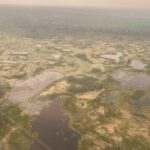Task 245
Develop Satellite Snow Data Assimilation Capabilities into the NASA Land Information System (LIS) to Support NWS Hydrologic Applications
Principal Investigator(s):
Y. Liu
Sponsor(s):
C. Peters-Lidard
Last Updated:
October 26, 2012 15:26:11
Description of Problem
Accurate snow prediction during snow accumulation and melting periods is essential for various hydrologic and water resources applications in snow-impacted regions. However, estimates of snow water equivalent (SWE) from current land surface models typically contain significant errors due to poor model physics in representing the snow processes and other sources of uncertainties such as inaccurate model forcing. Satellite-derived snow products, albeit subject to errors themselves, hold great potential for improving model snow predictions if properly assimilated into the models. This project represents a collaborative effort between NASA GSFC and the National Operational Hydrologic Remote Sensing Center (NOHRSC) of the National Weather Service, which aims to develop snow data assimilation (DA) capabilities into the NASA Land Information System (LIS) to integrate satellite-based SWE and snow cover fraction (SCF) products into several land surface models to improve snow prediction over the Alaska domain. The developed snow DA capability will be transferred to NOHRSC to support their hydrologic forecasting in Alaska and other research domains such as Afghanistan.
Scientific Objectives and Approach
Our approach consists of two major steps: 1) conduct comprehensive benchmarking efforts to understand and analyze the primary uncertainty sources in the model snow predictions, such as model forcing (e.g., precipitation and temperature) and model physics, by using multiple land surface models and multiple forcing sources; 2) based on the uncertainty analysis in step 1), conduct ensemble-based assimilation (e.g., using ensemble Kalman Filtering) of satellite-based SWE and SCF products from AMSR-E and MODIS into the land surface models, and evaluate the performance gain (in any) from data assimilation.
Accomplishments
For the benchmarking effort, 10-year (10/1/2000-9/30/2010) high-resolution (0.01degree, hourly) retrospective simulations were conducted with LIS 6.1 using three land surface models (i.e., CLM2, Noah 2.7.1, and Noah3.2) and three different precipitation forcing sources (i.e., GDAS, CMAP, and station precipitation). Our results (Fig. 1 and Fig. 2) indicate that a large portion of the uncertainty in snow prediction comes from precipitation, while there also exists considerable uncertainty in model physics and other forcing terms such as radiation and temperature.
For the data assimilation efforts, the error-prone SWE observations from AMSR-E were first bias-corrected using in-situ snow observation from NWS COOP and other stations, prior to being assimilated into the models using an EnKF based technique. As expected, this has led to considerable improvement in snow predictions as compared to in-situ snow observations. For independent verification of the data assimilation results, we compared the monthly discharged computed by the models (with and without SWE assimilation) with USGS streamflow observations at 12 selected gages (Fig. 3) and conclude that, while SWE assimilation has little or no effect on streamflow prediction at some gages, it does lead to significant improvement at most gage locations with snow-dominant flow regimes. More investigation with SCF assimilation is underway, but we expect to see less improvement compared to SWE assimilation as already demonstrated in some previous studies.
The snow DA capability will be completed in the next couple of months and will be delivered to the NOHRSC. Two manuscripts (focusing on benchmarking and data assimilation, respectively) are being prepared and will be submitted to appropriate journals in the next few months. Other related publications and conference presentations are given below.
Other Publications and Conferences
Journal Publications:
Liu, Y., A.H. Weerts, M. Clark, H.-J. Hendricks Franssen, S. Kumar, H. Moradkhani, D.-J. Seo, D. Schwanenberg, P. Smith, A. van Dijk, N. van Velzen, M. He, H. Lee, S.-J. Noh, O. Rakovec, and P. Restrepo, 2012: Toward advancing data assimilation in operational hydrologic forecasting and water resources management: a review of the current status, challenges, and emerging opportunities, Hydrol. Earth Syst. Sci., submitted.
Kumar, S. V., C.D. Peters-Lidard, J. Santanello, K. Harrison, Y. Liu, and M. Shaw, 2012: Land surface Verification Toolkit (LVT) – a generalized framework for land surface model evaluation, Geosci. Model Dev. Discuss., 5, 229-276, doi:10.5194/gmdd-5-229-2012 (published as a discussion paper).
Lee, H., D.-J. Seo, Y. Liu, V. Koren, P. McKee, and R. Corby, 2012: Variational assimilation of streamflow operational distributed hydrologic models: effect of spatiotemporal adjustment scale, Hydrol. Earth Syst. Sci. Discuss., 9, 93-138 (published as a discussion paper).
Conference Presentations:
Liu, Y., C. D. Peters-Lidard, S. Kumar, Y. Tian, and K. Arsenault: A multi-model multi-forcing approach to benchmarking snow predictions in Alaska using the NASA Land Information System, 26th Conference on Hydrology, AMS Annual Meeting, New Orleans, Louisiana, Jan 22-26, 2012.
Kumar, S., C. D. Peters-Lidard, J. Santanello, K. W. Harrison, Y. Liu, and M. Shaw: Land Verification Toolkit (LVT): a formal benchmarking and evaluation framework for land surface models, 26th Conference on Hydrology, AMS Annual Meeting, New Orleans, Louisiana, Jan 22-26, 2012.








